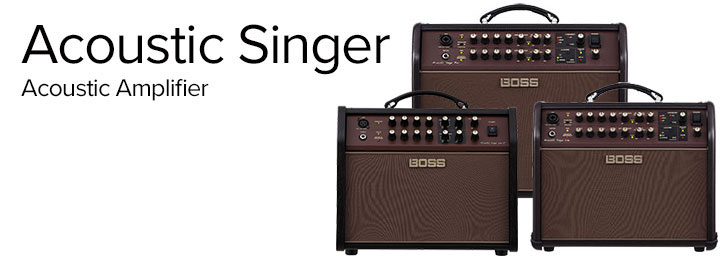The BOSS Acoustic Singer series of amplifiers is designed for the guitarist/vocalist who needs one self-contained unit for handling all of their amplification needs; acoustic guitar, vocals, maybe even effects and backing tracks. The idea is that you can rock up for a gig with your amp in one hand and your guitar case in the other hand have pretty much everything you need to perform.
There are three amps in the series: ACS Pro, ACS Live, and the new ACS Live LT.
The ACS Pro sits at the top of the range, with a 100W woofer and 20W tweeter affording you the power to provide stage volume and play to bigger crowds.
Next is the ACS Live with a 50W woofer and 10W tweeter – perfect for those small to medium-sized gigs.
Both of these amps feature a variety of stage- and recording-ready features, as well as some extra tools to take your creativity to the next level like in-built looper and intelligent vocal harmoniser! They also include a two-button footswitch so that you’re gig-ready right off the bat.
The baby of the range is the Acoustic Singer Live LT, a more streamlined model for players who don’t need the looper and harmony features. There are still two channels for connecting an acoustic/electric guitar and a vocal mic, plus dedicated EQ and effects for independent sound shaping.
Let’s talk through how to set up your Acoustic Singer amp and get ready to play.
Setting Up
First you’ll want to set your input levels. First turn your master volume and the two channel volumes (Guitar and Mic) all the way down so you don’t get any nasty high-volume thuds or squeals.
Plug in your instruments (and the foot controllers if you have them), power the amp on and adjust your inputs. Turn the master volume up a little then set each channel volume so that the loudest sounds fall just short of distorting. It’s always a good idea to make sure you don’t turn your amp on until everything is plugged in.
Using Acoustic Resonance
Using Anti-Feedback
Using Guitar Effects
Using Mic Effects
Using The Harmony Feature
Using The Looper Feature
The Looper section (only for ACS Live and Pro) is exclusive to the Guitar channel, and allows you to record and play back layers of guitar parts to create complex backings. You can use an FS-6 foot switch to record and replay your loops.

